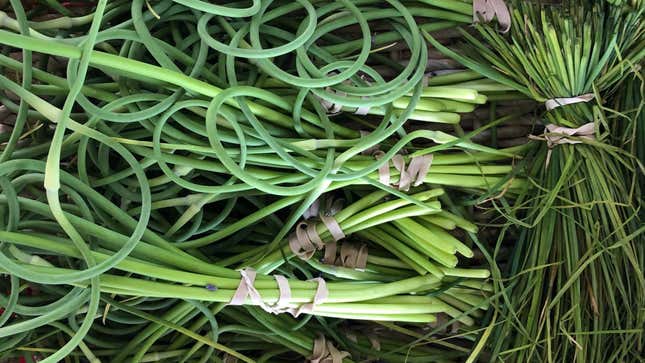
Garlic scapes are an easy impulse buy at the farmer’s market. Vendors lure you in with the promise that these green curlicues are only available for a few short weeks every year (see also: ramps), plus scapes are shaped like a Dr. Seuss invention. “How fun, I’ll take six!” But what to actually do with them once you’re home?
I didn’t buy my garlic scapes, actually; they grow wildly from the tops of the few rows of garlic in my backyard garden. And they shoot up all at once, meaning I have to use them or lose them, and quick. This year, I committed myself to learning more about these summertime squiggles so I’d feel empowered to actually cook with them.

First, I consulted Abra Berens’ new book, Ruffage, a thorough compendium of vegetable knowledge. I learned that garlic scapes are the flowering portion of the garlic plant, and, if left alone, they’ll put out chive-like blossoms that eventually create dozens of small cloves. So removing the scape doesn’t just give us a new portion of the plant to eat, but it encourages the garlic to put its energy into growing the underground bulb rather than its flowers. Berens says scapes can be substituted for garlic cloves in most recipes at a ratio of five scapes per three cloves called for. The scapes have a more mild flavor, which she calls a “grassy sweetness;” I think they taste like a cross between garlic, scallions, and asparagus. You could easily nibble them raw.
So this week, I substituted garlic scapes for cloves in all my meals. They worked every time: in a vinaigrette dressing, as a marinade for skirt steak (eventually bound for tacos), in a rice noodle stir-fry, in a spinach-and-garlic pasta. The scapes had the added benefit of adding a small crunch to dishes, like scallions do, and because they’re more mild, biting into a larger chunk of one doesn’t produce the same pungent surprise as a clove would.
My favorite recipe, though, is Berens’ sauteéd garlic and spinach pasta, reprinted below. It uses up 10 garlic scapes (or six cloves, if you don’t have them), and called for a whole bag of spinach, another vegetable my garden is putting out in abundance right now. It’s a true fridge-clearing recipe, if your fridge looks like mine. But whatever you choose to make with your garlic scapes, remember they’re more versatile than you think. Don’t let the spirals intimidate you.

Garlic and spinach pasta
Reprinted from Ruffage by Abra Berens with permission by Chronicle Books, 2019
Making a pan sauce can be a bit of a trick, but the more you do it, the easier it will be. If your sauce breaks (the solids separate from the liquid), add a bit more butter to bring it back together. I always end up doubling the amount of garlic in any cookbook recipe I’ve ever made. This pasta has a real garlic punch. If you want a tamer dish, feel free to cut the amount of garlic in half.
This dish with green garlic is one of my favorite foods in the spring.
- 1 small onion, cut into thin slices
- 6 garlic cloves (or 10 garlic scapes), slivered
- Butter for frying
- Salt
- 1/2 cup white wine or dry vermouth
- 1 cup chicken or vegetable stock or water
- 4 Tbsp. anchovy–caper butter (see below), cut into cubes
- 1 cup cream
- 1 lb. long pasta, just finished cooking
- 1 bag (4 oz., 115 grams) spinach, chopped into strips
- Raclette or Parmesan cheese
Anchovy-caper butter
Combine all ingredients and blend well. Transfer to a dish or roll into a round in plastic wrap and chill.
- 4 oz. butter, softened
- 1/2 tsp. salt
- 1/2 tsp. freshly ground black pepper
- 1 oz. capers, roughly chopped
- 1/4 bunch (1/4 cup) parsley, finely chopped
- Zest of 1 lemon
- 4 anchovy filets, roughly chopped (optional)
In a shallow frying pan, sweat the onion and garlic in a knob of the butter and a pinch of salt over low heat until soft, 5 to 7 minutes. Add the wine and reduce by half, about three minutes. Increase the heat and add the stock.
When the liquid comes to a boil, add the butter and cream and let reduce until slightly thickened, 3 to 5 minutes.
Drain the pasta and toss with the sauce and the spinach, allowing the heat of the pasta to wilt the spinach.
Serve with a satisfyingly hefty grating of cheese.